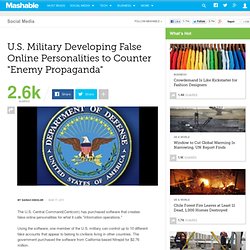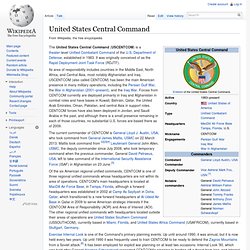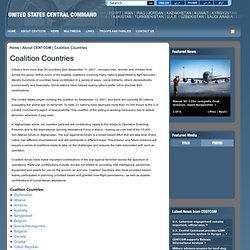

U.S. Military Developing False Online Personalities to Counter "Enemy Propaganda" The U.S.

Central Command(Centcom) has purchased software that creates false online personalities for what it calls "information operations. " Using the software, one member of the U.S. military can control up to 10 different fake accounts that appear to belong to civilians living in other countries. The government purchased the software from California-based Ntrepid for $2.76 million. "The technology supports classified blogging activities on foreign-language websites to enable Centcom to counter violent extremist and enemy propaganda outside the U.S. ," Centcom spokesperson Commander Bill Speaks told The Guardian. Operations that the software could be used for include countering disinformation campaigns, military deception, computer network operations or hacking, according to the Washington Times. U.S. Central Command (@CENTCOM) sur Twitter. United States Central Command. Of the six American regional unified commands, CENTCOM is one of three regional unified commands whose headquarters are not within its area of operations.

CENTCOM's main headquarters is located at MacDill Air Force Base, in Tampa, Florida, although a forward headquarters was established in 2002 at Camp As Sayliyah in Doha, Qatar, which transitioned to a new forward headquarters at Al Udeid Air Base in Qatar in 2009 to serve American strategic interests if the CENTCOM Area of Responsibility (AOR) and Area of Interest (AOI). The other regional unified commands with headquarters located outside their areas of operations are United States Southern Command (USSOUTHCOM), currently based in Miami, Florida, and United States Africa Command (USAFRICOM), currently based in Stuttgart, Germany. Exercise Internal Look is one of the Command's primary planning events. Up until around 1990, it was annual, but it is now held every two years. History[edit] In 1983, U.S.
Components[edit] Sub-unified command. Coalition Countries. Citizens from more than 80 countries died September 11, 2001 - innocent men, women and children from across the globe.

Within hours of the tragedy, coalitions involving many nations assembled to fight terrorism - literally hundreds of countries have contributed in a variety of ways - some militarily, others diplomatically, economically and financially. Some nations have helped openly; others prefer not to disclose their contributions. The United States began building the coalition on September 12, 2001, and there are currently 50 nations supporting the global war on terrorism. To date, 21 nations have deployed more than 16,000 troops to the U.S. Central Command's region of responsibility. In Afghanistan alone, our coalition partners are contributing nearly 8,000 troops to Operation Enduring Freedom and to the International Security Assistance Force in Kabul - making up over half of the 15,000 non-Afghan forces in Afghanistan. Coalition Countries: U.S. Central Command. U.S. Military Developing False Online Personalities to Counter "Enemy Propaganda" United States Central Command, CENTCOM (PETER ANTILL)
The Reagan Administration and Emergence of CENTCOM The United States Central Command Operations Desert Shield and Desert Storm After Desert Storm The Reagan Administration and Emergence of CENTCOM The Rapid Deployment Joint Task Force (RDJTF) had been officially activated on the lst March 1980 and based at MacDill Air Force Base under the US Readiness Command.

In the words of it's first commander, General P.X.Kelley, "It's the first time that I know of that we have ever attempted to establish, in peacetime, a full four service Joint Headquarters" [note 1] and "the only group in this country whose current full time activities focus on joint and combined combat operations" [note 2] for a limited contingency operation. The aim of the RDJTF was that of deterrence - against possible Soviet or proxy invasion, conflict among the states of the area and subversion and insurrection within the states and thus "help maintain regional stability and the Gulf oil-flow westward".
After Desert Storm. United States Central Command.